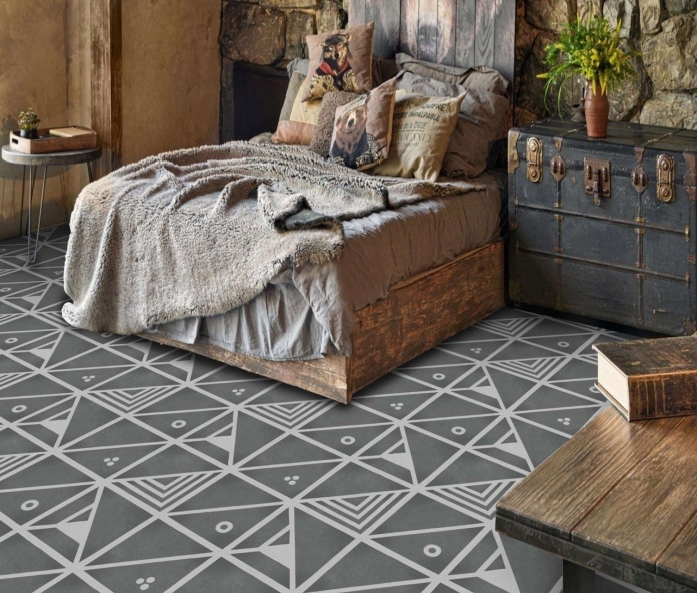Our bathroom floor is slippery due to regular water leakage. For safety, choose slip resistant tiles that lessen the risk of slipping or falling and do not become slippery when wet. Most reputable tile manufacturing businesses assign a slip rating to their tiles to specify frictional resistance.
This is determined by the COF (coefficient of friction) value of the tiles, with tiles with a COF value greater than 0.6 being regarded safe for bathrooms or other damp areas of our home.
Here are 10 different options that offer good slip resistant tiles and come in a variety of styles and materials to suit your taste and budget:
- Textured Porcelain Tiles: These are a popular choice for bathroom floors due to their durability, water resistance, and variety of textures. You can find textured porcelain tiles that mimic the look of stone or wood, with a matte finish or raised pebble-like designs for added slip resistance.
- Stone Composite Tiles: Made from recycled stone, resin, and pigments, these tiles are durable, water-resistant, and come in a variety of styles that mimic natural stone at a lower cost. They often have a naturally textured surface that provides good slip resistance.
- Mosaic Tiles: Small mosaic tiles, especially those made with a textured stone or glass material, can create a slip-resistant surface with a unique and decorative look. Just be sure the grout lines are properly sealed to prevent moisture build-up.
- Slate Tiles: Natural slate tiles have a beautiful natural cleft surface that offers excellent slip resistance. They come in a variety of earthy tones and add a touch of organic luxury to your bathroom. However, slate can be porous and requires sealing to prevent staining.
- Engraved Porcelain Tiles: These tiles have a patterned or linear design etched into the surface, creating a visually interesting and slip-resistant floor. They come in a variety of colors and styles to suit your taste.
- Pebble Tiles: Pebble tiles, made from natural or manufactured pebbles, create a unique and spa-like feel underfoot. They offer excellent slip resistance due to their naturally textured surface. However, pebble tiles can be uncomfortable to walk on barefoot and may be more difficult to clean due to the spaces between the pebbles.
- Textured Ceramic Tiles: Similar to textured porcelain tiles, textured ceramic tiles offer good water resistance, affordability, and a variety of surface textures for slip resistance. They are a great budget-friendly option for slip-resistant bathroom floors.
- Luxury Vinyl Tile (LVT) with Textured Finish: LVT is a waterproof and comfortable option that can also be slip-resistant. Look for LVT with a textured or matte finish for better traction underfoot. LVT is also easy to install and maintain.
- Rubber Tiles: While not the most aesthetically pleasing option, rubber tiles offer exceptional slip resistance and a soft, comfortable feel underfoot. They are a good choice for areas like shower floors where safety is a top priority.
- Cement tiles: Cement tiles have a naturally rough and porous surface that qualifies to the basic standards of slip-resistant tiles. These tiles are a great way to impart a vintage look to your bathroom and are available in bold and traditional colours and patterns.Remember, the best slip-resistant tile for your bathroom will depend on your specific needs, budget, and desired aesthetics. Consider factors like the level of slip resistance required, the amount of foot traffic, and your design preferences when making your choice.
FAQS
Ques 1. How do slip resistant floor tiles differ from regular tiles?
Ans:- The key difference lies in their surface texture:
- Regular Tiles: These tiles have a smooth, polished surface that can become slippery when wet. This is especially true for glazed ceramic or porcelain tiles.
- Slip-Resistant Tiles: These tiles are designed to provide better traction underfoot, even when wet. They achieve this through various features like:
- Textured Surface: Raised bumps, grooves, or a matte finish increase friction and prevent slipping.
- Increased Coefficient of Friction (COF): A higher COF rating indicates a greater slip resistance. Tiles suitable for wet areas should have a COF of 0.6 or above.
Ques 2. What are some key factors to consider when choosing slip resistant bathroom floor tiles?
Ans :-Here are some important factors to consider when selecting slip-resistant tiles for your bathroom:
- Level of Slip Resistance: Consider the specific use of the area. Shower floors and tub surrounds require the highest level of slip resistance (COF 0.8 or above). Bathroom floors outside the shower or tub can have a slightly lower COF (0.6 – 0.7).
- Surface Texture: Choose a texture that provides good traction without being too uncomfortable underfoot. For example, small raised bumps or a matte finish offer good slip resistance without feeling harsh.
- Material: Many materials can be slip-resistant, including textured ceramic or porcelain tiles, stone tiles with a natural grip (like slate), or even some luxury vinyl tiles (LVT) with a textured surface.
- Aesthetics: Slip-resistant tiles come in a variety of styles and colors. Choose one that complements your overall bathroom design.
- Maintenance: Some textured surfaces might trap dirt or require more effort to clean. Consider the ease of maintenance when making your selection.
Ques 3. Why are slip resistant bathroom floor tiles important?
Ans :- Slip-and-fall accidents are a major concern in bathrooms, especially for young children, older adults, or those with mobility limitations. Slip-resistant tiles can significantly reduce the risk of these accidents by providing better traction underfoot, even when the floor is wet.
Here’s why they’re important:
- Safety: They minimize the risk of slips and falls, preventing potential injuries.
- Peace of Mind: Knowing your bathroom floor is safe for everyone provides peace of mind.
- Accessibility: Slip-resistant tiles create a safer environment for people with mobility issues.
- Increased Value: They can add value to your home, especially if you plan to sell it in the future.








